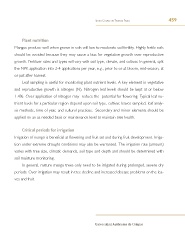Page 459 - FRUTAS DEL TRÓPICO
P. 459
459
shoRt couRse on tRopical fRuits
Plant nutrition
Mangos produce well when grown in soils will low to moderate soil fertility. Highly fertile soils
should be avoided because they may cause a bias for vegetative growth over reproductive
growth. Fertilizer rates and types will vary with soil type, climate, and cultivar. In general, split
the NPK application into 2-4 applications per year, e.g., prior to or at bloom, mid-season, at
or just after harvest.
Leaf sampling is useful for monitoring plant nutrient levels. A key element in vegetative
and reproductive growth is nitrogen (N). Nitrogen leaf levels should be kept at or below
1.4%. Over application of nitrogen may reduce the potential for flowering. Typical leaf nu-
trient levels for a particular region depend upon soil type, cultivar, leaves sampled, leaf analy-
sis methods, time of year, and cultural practices. Secondary and minor elements should be
applied on an as needed basis or maintenance level to maintain tree health.
Critical periods for irrigation
Irrigation of mango is beneficial at flowering and fruit set and during fruit development. Irriga-
tion under extreme drought conditions may also be warranted. The irrigation rate (amount)
varies with tree size, climatic demands, soil type and depth and should be determined with
soil moisture monitoring.
In general, mature mango trees only need to be irrigated during prolonged, severe dry
periods. Over irrigation may result in tree decline and increased disease problems on the lea-
ves and fruit.
Universidad Autónoma de Chiapas

